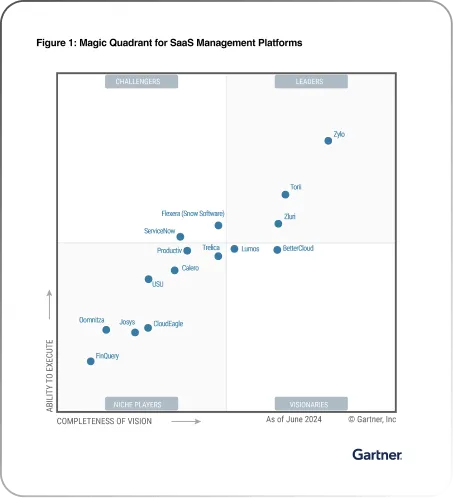The software industry has seen explosive growth due to SaaS, which changed how businesses procure and use software. During the pandemic, it was SaaS that helped businesses survive.
When it comes to purchasing SaaS, there are many types of pricing models offered by the vendors, which usually could be a bit confusing for IT teams in the beginning.
Around two decades back, IT/Procurement teams had to buy software manually. That is, buy the software disk, install it on every pc, enter the unique product code, maintain the software, and it goes on. On-prem software was expensive, and it also involved maintenance costs.
But with SaaS, anyone in an organization can sign up for apps and use them as they wish. Furthermore, with many apps providing freemium options, you wouldn't need to pay anything until a stipulated time frame.
SaaS vendors usually offer free trials or a freemium model, where users get to explore the app for free, after which they can decide whether to continue or not. To increase their profits and make their platform prominent among companies, SaaS vendors use various pricing models.
Though not possible with an end-user license, when buying an enterprise license agreement, it is on the onus of the buyers to negotiate the model that best suits their organization. But the pricing model can be initially confusing. There could be many questions like what plan to choose, which would be beneficial for you, what is included & what is not included etc.
This article will take you through the commonly used SaaS pricing models, how it is structured and what you should choose.
The primary model of SaaS is paying a subscription fee for using a product/service. It involves ongoing payments that follow pricing models which the SaaS vendor might offer after considering their profits and value for the buyers.
A 2020 survey by Gartner has found that 90% of IT leaders cited the pricing model as an important factor in making SaaS purchasing decisions.
SaaS Pricing Models
There are numerous SaaS pricing models available; in this article, we will see the most popular models used by the SaaS vendors.
Cost-based pricing
This is the most simple pricing model that has just one price. In this model, SaaS vendors first analyze the costs to provide and support the SaaS application. Then add a profit margin. Those who prefer a straightforward approach opt for cost-based strategies.
Flat rate pricing
- This is the most straightforward SaaS pricing model available. In flat-rate pricing, you are offered a single product with a single set of features at a single price.
- This is not a very common option given by vendors, but it can be an effective, simple solution for the buyers. There won't be any costly extra add-ons or exclusive features, no user limits, and it is very easy to communicate.

- Basecamp, a project management software provider, charges $99/month for its entire suite of features. It also gives unlimited access to unlimited users.
- Though transparency, simplicity, and predictability can be called the important aspects of pricing models, most SaaS vendors rarely offer flat pricing models due to their narrow scope and lack of flexibility.
- If you don't need any customizations when buying SaaS for your organization, you can opt for flat-rate pricing.
Pros
- Simple, transparent, and easy to understand
- Best for those who wish to have their budgets predicted beforehand
- Low maintenance
- Easily manageable contracts
Cons
- Un–customizable package
- High costs, less value
- SaaS vendors wouldn't care about customer value
- Lack of engagement from a vendor might lead to discontinuing the app
Value-Based Pricing Models
The foundation of a value-based pricing model is what you consider as a needed value from a SaaS application. For this approach, it is the onus of the SaaS vendors to analyze and have a solid understanding of what their customers consider as value.
This value-based pricing model can be beneficial for you mainly because the SaaS vendors offering this model will always be updated about what their customers want and roll out regular feature updates to enhance their product capabilities.
But, when you find a SaaS product that brings lots of value to your business, you often ignore the cost; this is a benefit for the vendor.
1. Freemium Pricing
In this model, you can use a product for free but with a limited feature set. You get to explore and use the app with limited features to get a basic idea of its UI and efficiency and later choose to get upgraded to their premium plans if you are satisfied. This is a very common model in SaaS pricing and is a part of a tiered pricing model, which we will see later in this article.
Since you get a taste of the platform before you pay for it, you wouldn't need to spend unnecessarily before knowing the product.
DropBox, a cloud storage platform, can be a good example of the Freemium Pricing model. It offers the \"Basic\" tier free of cost with a limited set of features.

Pros:
- Free
- Easily manageable contracts
- Increases product awareness
- Trial without investment
Cons:
- It cannot be customized
- SaaS vendors wouldn't care about customer value
2. Tiered Pricing
Tiered pricing can be called the de-facto pricing model used by most SaaS vendors. It is the exact opposite of flat pricing and offers multiple packages at multiple prices. This is mainly to cater to the interest of different buyer personas.
Though the benefits offered in various tiers might vary, it is mostly categorized based on the number of users, usage, features, etc. The one with the highest features comes with higher price tags. Even when there are a lot of options to choose from, it might be a bit overwhelming in the beginning.

Well-known office suite app Office 365 from Microsoft uses tiered pricing starting with basic E1, which rises to the highest in E5
Pros:
- Tailored packages to suit your individual needs
- Can upgrade to the next tiers after seeing the value
Cons:
- Tempting to opt for the top-most tier even though most of the features are not needed.
- Too many options might get overwhelming.
3. Feature Pricing

Another popular SaaS pricing model that offers various pricing tiers based on the features it provides is the feature-based pricing model. The more features, the more value you can expect.
Therefore, the more features, the higher the pricing. You basically pay for whatever you have opted for. This paves the way for more customized service and pricing plans, so you should pay different prices based on what you actually need.
The most prominent cloud-based software company Salesforce uses a tiered feature-based pricing model.
Pros:
- Easily manageable contracts
- Lower tiers can be opted for trial
- Simple pricing
- Pay only for the features you use
Cons:
- Most needed features may be present only in higher tiers
- Overlapping features might feel redundant
4. Per-user and per-active-user pricing
Per-user and per-active-user come under the pay-as-you-go model. In per-active-user, you will only be charged for the end-users signing into an app. Whereas in the per-user model, you will have to pay for the number of users determined by you, regardless of them using the app.
The Per-active-user model can be very much beneficial to you, but it is not offered frequently by SaaS vendors due to the difficulty in predicting revenues.

Slack, the business communication platform, can be a good example of a per-active-user model.
Pros:
- Best for limited users
- Simple and transparent in the pricing
- Avoid paying for idle apps in the per-active-user model
Cons:
- Doesn't work the best always for enterprise apps
- End users sharing their logins might cause difficulty in budgeting in the case of the per-active user model
- Paying for inactive users in the per-user model
Zluri’s SaaS Buying Service
With so many pricing models, buying SaaS is tricky indeed. You may find yourself stuck and overwhelmed at several steps, wondering what to choose and how to choose.
SaaS resources will bring maximum value to your workplace if chosen wisely. If at any point you feel lost, Zluri has procurement experts in place who can make your SaaS buying experience effortless!
Zluri knows the SaaS marketplace and can help you get the best SaaS stack for your company in your budget and can also help you plan your SaaS buying in advance, with savings up to 50% on subscriptions and zero upfront cost - You pay when you save and on better terms with us.









.svg)





























.webp)







.webp)
.webp)





.webp)